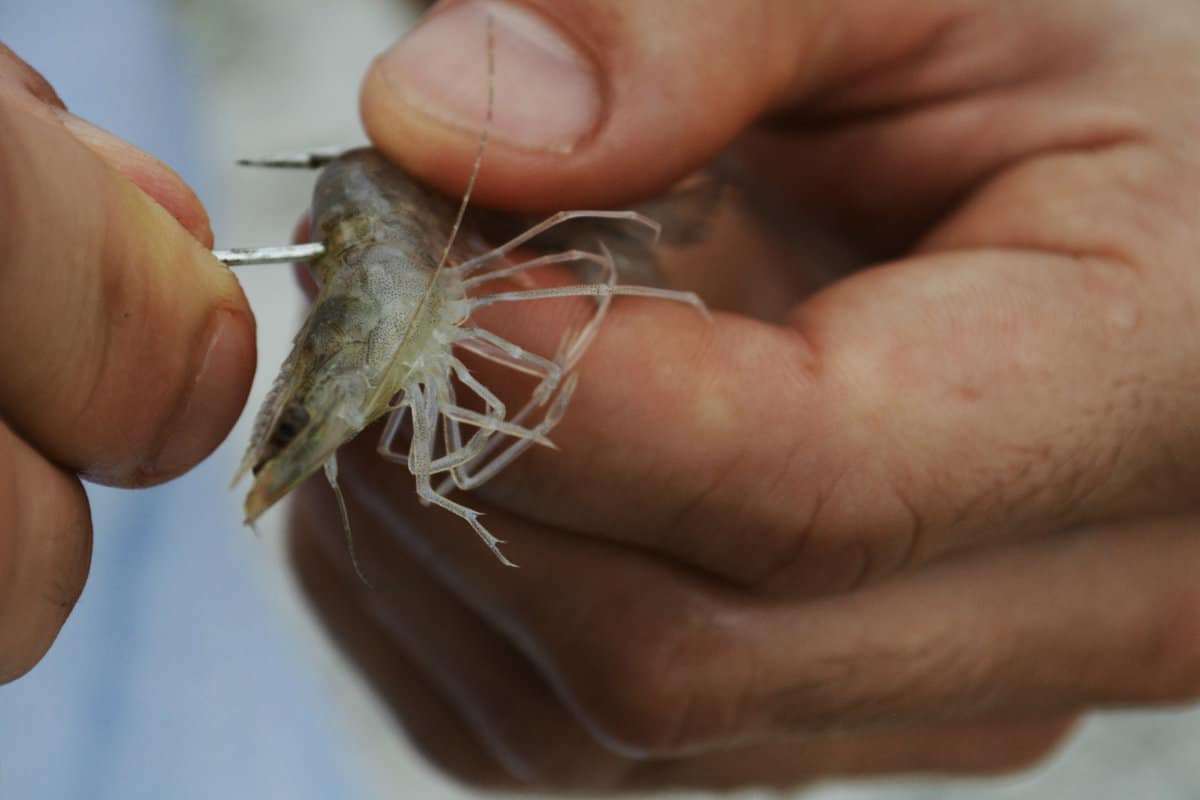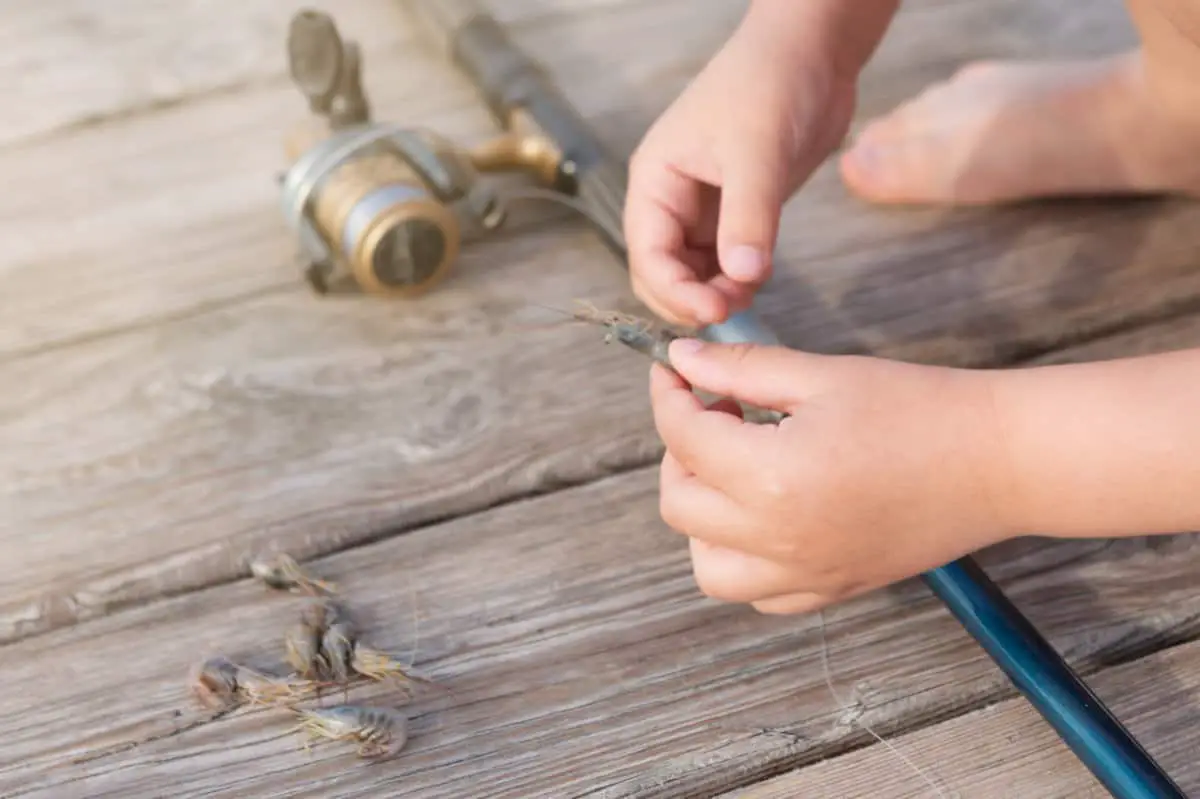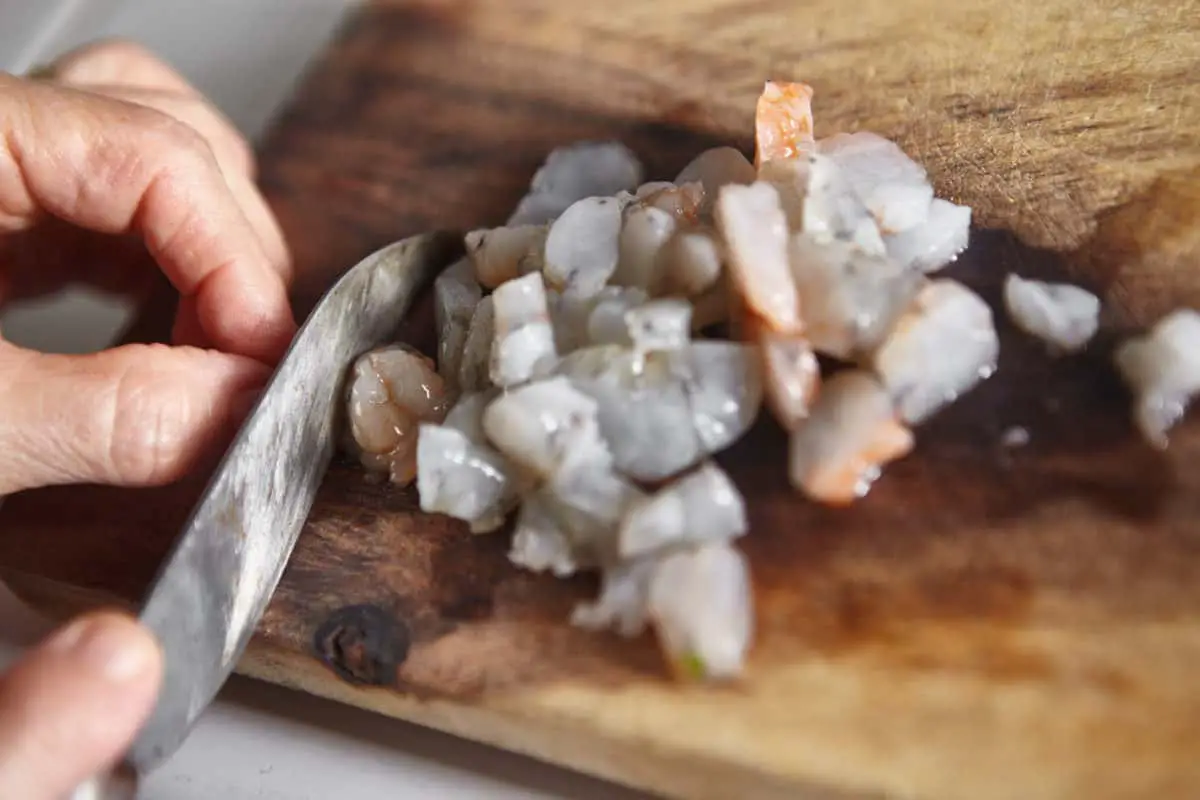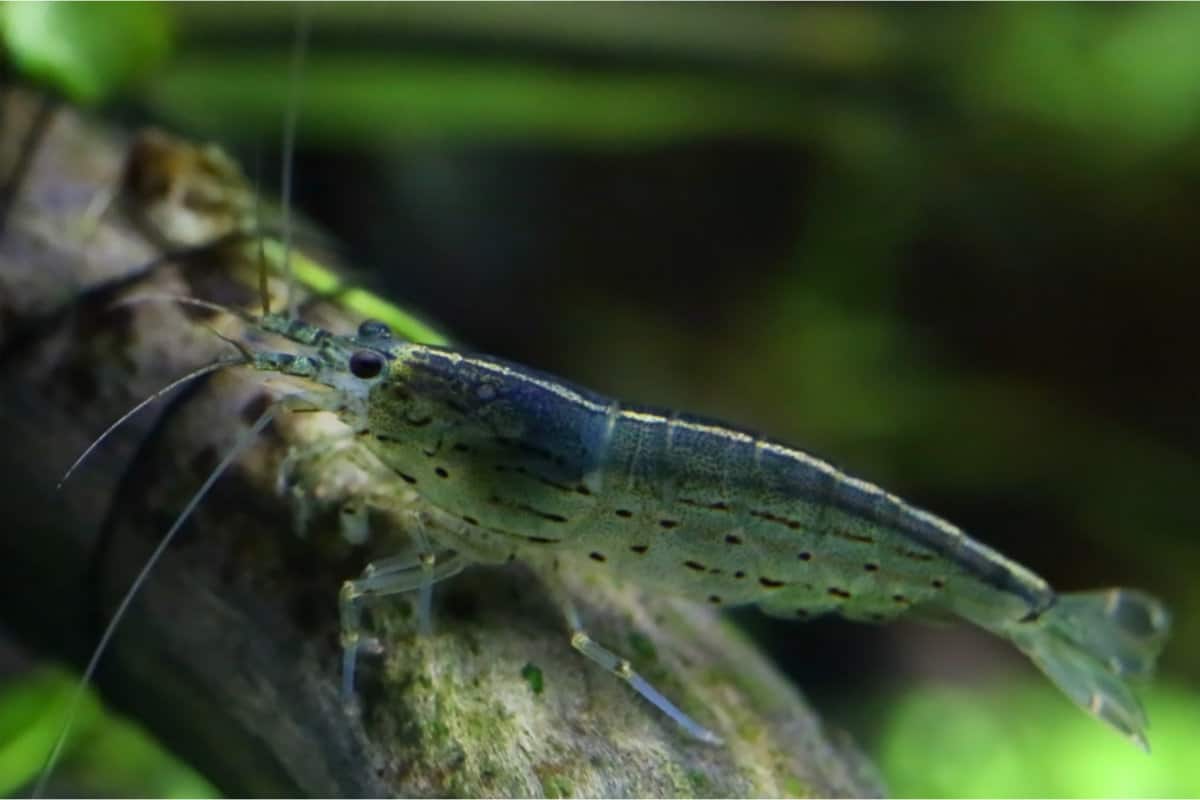Shrimp is one of the most popular forms of fresh bait used for surf fishing but knowing how to hook them properly and which kinds of shrimp to use are vital to success when using them. If shrimp are hooked incorrectly, their movement can be compromised. They can sometimes be killed outright, greatly reducing their effectiveness as live bait.
So how do you hook shrimp for surf fishing? Shrimp can be hooked through the head, through the middle, or through the tail. Each of these hooking methods offers different advantages such as longevity, security on the hook, or freedom of natural movement.
This beginner’s guide will also teach you what kind of shrimp are used as bait, what kind of hooks you should use, and how to keep your bait shrimp alive for best surf fishing results. Read on and find out more about using shrimp as bait and how you should set one on a rig.
Using Bait Shrimp for Surf Fishing
Shrimp is a great bait for surf fishing largely because of its versatility. Shrimp can be used in a variety of sizes, can be used as either live or cut bait, and can even be used cooked. Surf dwelling fish such as whiting, surfperch, and pompano also enjoy shrimp as a major source of food in the wild and are attracted to it when they smell it hit the water.
Using a scent bait like shrimp allows you to draw fish in from a further distance, and also allows you to fish a wide variety of different species. Everything from stripers to small sharks will take a live shrimp on a hook.
Here are some types of shrimp most commonly used as bait while surf fishing:
- Ghost shrimp: Ghost shrimp are a slow-moving, brightly colored shrimp that is especially attractive to surf fish such as croakers and corbina. Ghost shrimp are not usually found in coastal bait shops but can be foraged using a ghost shrimp pump.
- Pink shrimp: Pink shrimp is one of the most popular food shrimps harvested out of the Gulf of Mexico, and are often found in Gulf bait shops. This shrimp is collected as juveniles for bait and are collected as adults for table fare.
- Brown shrimp: Brown shrimp (also known as red shrimp) are harvested all along the Atlantic seaboard and in the Gulf of Mexico. This shrimp is preyed on extensively by a wide variety of fish species at all life stages.
- Northern white shrimp: White shrimp is another common variation of shrimp that are caught and used as bait. These shrimps are plentiful and reproduce annually, which makes them an ecologically renewable source for fishing bait.
Wherever you get your bait shrimp, be sure that whatever whole bait shrimp you use is native to the area you’re using it in unless you’re using cooked shrimp. Non-native shrimp used whole can introduce deadly new viruses such as white spot syndrome virus into native ecosystems.
Shrimp bait can be either purchased in bait shops (where it is often available in a variety of sizes and corresponding prices) or foraged and caught with a cast net![]() .
.
For the freshest bait available if you’re able to easily net shrimp in the area, you’re planning on surf fishing. Then you can bet your shrimp is going to act as a very effective bait in that same spot.
What Hooks to Use with Shrimp
What kind of hooks you use with shrimp dictate how you hook the shrimp on them, and the type of tackle rigs you need to use are the ones designed specifically for surf fishing. Surf fishing is different than offshore fishing because you have to account for the action of the surf, which can tumble your tackle and potentially rip your bait off the hook.
One good option of hook style to use with shrimp is a baitholder hook.![]() These hooks feature a series of razor-sharp secondary hooks designed to snag a piece of bait securely in place. This prevents the bait from falling off the hook and prevents more aggressive striking fish from ripping the bait off the hook without setting it.
These hooks feature a series of razor-sharp secondary hooks designed to snag a piece of bait securely in place. This prevents the bait from falling off the hook and prevents more aggressive striking fish from ripping the bait off the hook without setting it.
One issue you will probably have to deal with when using shrimp as bait is bait thieves. These fish will attempt to eat the shrimp directly off the hook, and the only real way to combat this is to use baitholder hooks and don’t use a hook larger than the shrimp. The larger the hook is than your bait, the better the chance is that a fish will rip it off the hook without swallowing it.
Another option of a hook to use with shrimp bait is a circle hook![]() . Circle hooks are a good choice because they have been shown to increase the survivability of fish that are caught and released. For those anglers who are surf fishing but do not intend to harvest their catch for food, circle hooks provide the best option to return the fish to the water without killing it.
. Circle hooks are a good choice because they have been shown to increase the survivability of fish that are caught and released. For those anglers who are surf fishing but do not intend to harvest their catch for food, circle hooks provide the best option to return the fish to the water without killing it.
How to Hook Live Shrimp on a Surf Fishing Rig

There are various ways that you can hook a whole shrimp onto a tackle rig as bait, and each way has its own advantages and disadvantages. Here are three methods you can use to hook a live shrimp for bait:
- Middle Hook: With this method, you hook the shrimp through the carapace (the middle part of the shrimp behind its head). When doing this, you must be sure to avoid the dark spots that indicate where the shrimp’s digestive system and pancreas are, as striking these areas can kill the shrimp quickly.
- This hooking method leaves the shrimp’s legs and tail free for kicking but can make for an awkward cast. This rigging method also leaves the shrimp in danger of being ripped partially off the hook, depending on the angle of the fish’s strike. However, a bait shrimp hooked in this way will live a relatively long time.
- Head hook: With this method, you hook the shrimp through the bottom of the head in the “chin” area, leaving the barbed top of the hook to come up and protrude through the top of the shrimp and curve over its head.
- This hooking method is a good way to leave the shrimp’s legs and tail free for movement and can ensure a better hook set if the fish strikes since the fish will strike from the tail up, but shrimp hooked this way tend to die more quickly.
- If you hook a shrimp through the head, be sure to avoid the dark part, as this is the location of the brain and piercing it will kill the shrimp instantly.
- Tail hook: With this method, you break the “fan” of the shrimp’s tail off at the end and pierce the hook through the meat of the tail.
- While this somewhat limits the shrimp’s natural movements, breaking off the tail at the first joint in this way causes the shrimp bleed hemolymph (the substance that acts as a shrimp’s blood) into the water and draw in hungry fish.
- This is also a very aerodynamic rig and allows a live shrimp to be cast further over the water without causing the bait to be ripped off in mid-air.
No matter which location you decide to hook a live shrimp at, you should be careful to avoid any dark parts of the shrimp beneath its shell exterior. These dark areas typically indicate vital organs and piercing them with the fishhook will cause the bait to die quicker. Dead shrimp can be used as a lure too, but you will lose some of the organic action of the live bait this way.
Hooking a live shrimp correctly is one of the most important aspects of using shrimp as bait because it is the living action of the shrimp that helps increase its attractiveness to fish.
Shrimp should be inspected periodically (every 15-20 minutes) to check and see if they are still alive. If not, the angler can choose to either continue casting with dead bait or set the dead shrimp aside for a live one. Dead shrimp can always be returned to as finishing bait once there is no bait left alive.
What Fish to Catch with Shrimp
One of the greatest benefits of surf fishing with shrimp as bait is that many, many species of surf-dwelling fish love to eat shrimp.
When you ask a seasoned saltwater fisherman, “Which fish can you catch with shrimp bait?” the answer is typically something to the effect of, “The first fish that can get to it.” That should give you some indication of the general popularity of shrimp as a food source for most coastal fish species.
Even fish that aren’t really that hungry can be tempted into striking a struggling shrimp.
Here are just a few of the many different species you can catch while surf fishing using shrimp as your bait:
- Pompano: Chances are if you’ve ever seen fishermen with a catch on a beach or pier, you’ve seen a few of them with a string of pompano. These silvery fish are one of the most popular saltwater panfish for culinary use in the world and are considered very easy to catch for beginners and veterans alike.
- Whiting: Whiting (also known as mullet or Southern kingfish) is a fish that skates around on the bottom in the surf zone, and enjoys preying on both shrimp and mollusks that live and travel in coastal troughs. Whiting is a popular panfish, and because they are a schooling fish, you can often catch several in one spot.
- Surfperch: Surfperch is an oval-shaped, live-bearing fish found in the surf zone of the Pacific seaboard. These fish stay small (under seven inches), making them perfect as panfish for eating. However, due to their small size, it does take a catch of several to feed a crowd.
- Sheepshead: Sheepshead is a coastal striped fish known for their eerie human-like teeth and is a popular eating fish due to their sweet flesh, a result of their shellfish-heavy diet. Surf anglers frequently catch sheepshead.
- Striped Bass: Also known as stripers, rockfish, and linesiders, striped bass can be found in both saltwater and freshwater habitats, making them one of the most widespread fish in the world. Saltwater striped bass can be caught at a few inches long to fish, weighing more than seventy pounds.
Using Shrimp as Live Bait

Using shrimp as live bait offers many advantages in the water over artificial lures when it comes to saltwater surf fishing. Shrimp afford the following advantages to anglers as live bait:
- provide lots of natural “wounded prey” movement that many fish find irresistible
- reflect light underwater due to their shiny shell exteriors for added visual attraction
- bleed scent into the water and act as chum to draw in predatory fish at long distance
Live bait can be preferable over artificial tackle for many reasons. Several species of fish are more intelligent than they appeared and can be resistant to striking artificial lures if they can see them well in clear waters. The smell and spastic movements of live natural baits can sometimes trigger feeding activity in fish that are not already feeding.
Shrimp also have the advantage of being one of the most widespread saltwater prey animals, which is one of the things that makes them so attractive to so many kinds of fish. Because they are also plentiful and not threatened by overfishing, their use as bait is likewise not threatening to local ecosystems.
Using Shrimp as Cut Bait
There can be a few reasons why people might not want to surf fish with live shrimp as bait. Either out of compassion or squeamishness, many anglers would rather not use live hooked bait for fishing.
Luckily for those who don’t want to deal with hooking a live shrimp as bait, there is also the option of using dead shrimp as bait instead. This can be either fresh shrimp (with or without the head) or cooked shrimp, as saltwater fish have been known to strike either.

In fact, parboiling whole shrimps as bait can toughen them up and cause them to stay on the hook more easily, where fresh shrimp meat is quite delicate and can be torn easily from the hook by an aggressive fish or a bait thief.
How to Use a Bait Bucket
One way to keep your shrimp lively if you’re planning a long session of surf fishing is to invest in an aerated bait bucket![]() . Aerated bait buckets provide oxygen to the shrimp in the bucket and keep them alive longer.
. Aerated bait buckets provide oxygen to the shrimp in the bucket and keep them alive longer.
Aeration is important in a bait bucket since shrimp are aquatic animals that draw oxygen from the water, and the oxygen in a bait bucket will be depleted quickly depending on how much live bait shrimp you have in it. Shrimp are sensitive, and if you have some dead shrimp in your bait bucket, these can stress and kill the others.
Aeration also helps to produce water flow in the bait bucket, which helps to keep the shrimp cool, aerated, and less stressed. The less stressed the bait in your bait bucket is, the longer it will survive in a lively state, and the more effective it will be on the hook.
Bait Bucket Temperature
Another important consideration when choosing a bait bucket is to choose a bucket that can be kept cool. Shrimp are killed more easily by heat than by lack of oxygen, and shrimp in a hot bucket of saltwater will die fast.
It is important to consider the stress on the bait shrimp not just because it will keep your bait livelier and more effective but also simply to be humane. Even though you are using live shrimp as bait, you can still reduce their distress while in captivity.
Keeping Bait Shrimp Alive and Fresh Without A Bait Bucket
If you don’t want to carry an aerated bait bucket while surf fishing, but you still want to bait with live shrimp, you can also keep shrimp alive by packing them into a cold cooler.
This puts the shrimp into a state of suspended animation, and shrimp can survive for several days without water in a chilled condition.
To keep shrimp alive without water, fill a cooler halfway with ice, put down a layer of newspaper soaked with seawater, then line the live shrimp up on top of the damp newspaper and tightly close the lid. This should keep the shrimp alive without water, which both decreases the overall weight of the cooler and the messy clean-up.
The most important trick with preserving the longevity of live shrimp bait is keeping temperatures low. As long as the shrimp stay cool, they should survive long enough to be lively on the hook.
Shrimp as Surf Fishing Bait
Shrimp is one of the most popular surf fishing baits used, and with good reason. Whether you prefer to fish with last night’s leftover chopped up cocktail shrimp or a wriggling live bait shop shrimp fresh out of the bucket, it’s hard to find a more versatile bait beloved by such a wide variety of different fish.
If you know how to hook a shrimp properly, you’ll not only have more successful strikes while you’re fishing, you’ll also lose less bait to casting, thieving fish, and rough surf.

